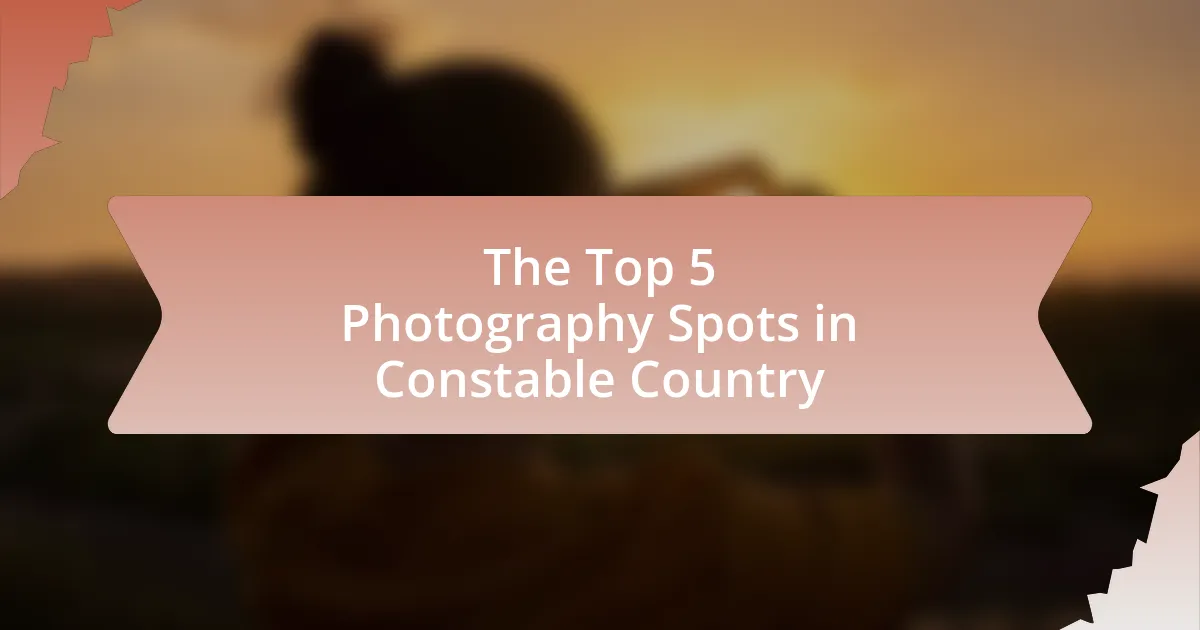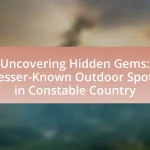The article focuses on the top five photography spots in Constable Country, highlighting Flatford Mill, Dedham Vale, East Bergholt, the River Stour, and the village of Dedham. Each location is noted for its scenic beauty, historical significance, and unique photographic opportunities, particularly those inspired by the works of artist John Constable. The article discusses the criteria for selecting these spots, the impact of natural lighting, and the best practices for capturing compelling images in this picturesque region. Additionally, it provides tips for photographers on equipment, composition, and environmental respect while shooting in Constable Country.

What are the Top 5 Photography Spots in Constable Country?
The top 5 photography spots in Constable Country are Flatford Mill, Dedham Vale, East Bergholt, the River Stour, and the village of Dedham. Flatford Mill is renowned for its picturesque scenery and historical significance, famously depicted in John Constable’s paintings. Dedham Vale offers stunning landscapes that inspired many of Constable’s works, showcasing rolling hills and lush greenery. East Bergholt, the birthplace of Constable, features charming cottages and scenic views. The River Stour provides beautiful waterways ideal for capturing reflections and natural beauty. Lastly, the village of Dedham is characterized by its quaint architecture and vibrant countryside, making it a perfect backdrop for photography.
Why is Constable Country a popular destination for photographers?
Constable Country is a popular destination for photographers due to its picturesque landscapes that inspired the renowned painter John Constable. The area features rolling hills, lush meadows, and serene rivers, which provide a rich tapestry of natural beauty ideal for capturing stunning images. Additionally, the region’s historical architecture, such as the iconic Flatford Mill and Dedham Vale, adds depth and context to photographs, making it a favored spot for both amateur and professional photographers seeking to capture the essence of the English countryside.
What historical significance does Constable Country hold for photography?
Constable Country holds historical significance for photography as it inspired the renowned landscape painter John Constable, whose work emphasized the beauty of the English countryside. His paintings, particularly “The Hay Wain,” captured the essence of the area and influenced early photographers who sought to replicate the natural beauty and atmospheric effects he portrayed. The region’s picturesque landscapes, characterized by rolling hills, rivers, and rural scenes, became a focal point for photographers in the 19th century, contributing to the development of landscape photography as an art form. Constable’s emphasis on light and color in his works laid the groundwork for future photographers to explore similar themes, making Constable Country a pivotal location in the history of photography.
How does the landscape of Constable Country enhance photographic opportunities?
The landscape of Constable Country enhances photographic opportunities through its picturesque scenery, characterized by rolling hills, lush meadows, and tranquil rivers. This unique combination of natural elements provides diverse backdrops for photographers, allowing for a variety of compositions and lighting conditions. The area is also rich in historical significance, as it inspired the renowned painter John Constable, whose works capture the essence of the landscape. The presence of iconic features such as Dedham Vale and the River Stour further enriches the visual appeal, making it a prime location for capturing stunning images that reflect both natural beauty and cultural heritage.
What criteria were used to select the top photography spots?
The criteria used to select the top photography spots in Constable Country include scenic beauty, historical significance, accessibility, and unique photographic opportunities. Scenic beauty is assessed through the area’s natural landscapes, such as rolling hills and picturesque rivers, which are characteristic of Constable Country. Historical significance is considered by evaluating locations that have inspired renowned artists, particularly John Constable, enhancing their appeal to photographers. Accessibility is measured by the ease of reaching these spots, ensuring that they are convenient for visitors. Unique photographic opportunities are identified by the presence of distinctive features, such as iconic trees or architectural elements, that provide compelling subjects for photography.
How do accessibility and location influence the selection of these spots?
Accessibility and location significantly influence the selection of photography spots in Constable Country by determining how easily photographers can reach these sites and the visual appeal of the surroundings. Locations that are easily accessible, such as those near major roads or public transport, attract more photographers due to convenience, allowing for spontaneous visits and extended shooting times. For instance, spots like Flatford Mill are popular because they are well-connected and offer picturesque views that align with the artistic vision of photographers. Additionally, the natural beauty and unique features of a location, such as the River Stour’s winding paths and scenic landscapes, enhance its desirability, making it a prime choice for capturing compelling images.
What role does natural lighting play in choosing these photography locations?
Natural lighting is crucial in selecting photography locations as it significantly influences the quality and mood of the images captured. In Constable Country, the interplay of natural light with the landscape enhances the visual appeal, creating dynamic contrasts and highlighting textures. For instance, the golden hour, which occurs shortly after sunrise or before sunset, provides soft, warm light that is ideal for landscape photography, making locations like Flatford Mill particularly attractive. Studies show that natural light can enhance colors and reduce harsh shadows, thereby improving the overall composition of photographs.

What are the specific features of each top photography spot?
The specific features of each top photography spot in Constable Country include unique landscapes, historical significance, and accessibility.
-
Flatford Mill: This location features the iconic mill and river scene that inspired John Constable’s paintings, offering picturesque views of the Suffolk countryside and opportunities for capturing reflections in the water.
-
Dedham Vale: Known for its rolling hills and lush greenery, Dedham Vale provides expansive vistas and diverse flora, making it ideal for landscape photography, especially during sunrise and sunset.
-
East Bergholt: This village showcases traditional English architecture and scenic views of the surrounding countryside, allowing photographers to capture both rural life and historical buildings.
-
Stour Valley: The Stour River meanders through this area, offering tranquil waterscapes and opportunities to photograph wildlife, particularly birds, in their natural habitat.
-
The Hay Wain Site: This spot features the exact location depicted in Constable’s famous painting “The Hay Wain,” providing a blend of historical context and natural beauty, perfect for recreating classic compositions.
What makes Flatford Mill a must-visit for photographers?
Flatford Mill is a must-visit for photographers due to its picturesque landscapes and historical significance. The mill, famously painted by artist John Constable, offers stunning views of the River Stour and surrounding countryside, making it an ideal location for capturing both natural beauty and cultural heritage. The area features iconic scenes such as the bridge and the mill itself, which provide excellent composition opportunities for photographers. Additionally, the changing light throughout the day enhances the visual appeal, allowing for diverse photographic styles and moods.
How can photographers capture the essence of Flatford Mill?
Photographers can capture the essence of Flatford Mill by focusing on its historical architecture, surrounding natural landscapes, and the play of light on the River Stour. The mill, built in the 18th century, offers a picturesque backdrop that reflects the rural charm depicted in John Constable’s paintings. Utilizing early morning or late afternoon light enhances the textures of the mill and the vibrant colors of the landscape, creating compelling compositions. Additionally, incorporating elements such as the weeping willows and the bridge can provide depth and context, emphasizing the serene atmosphere that characterizes this iconic location.
What unique angles or perspectives should be considered at Flatford Mill?
Unique angles or perspectives to consider at Flatford Mill include capturing the iconic view of the mill from the riverbank, which showcases its reflection in the water, creating a symmetrical composition. Additionally, photographing the mill during different seasons highlights the changing landscape, such as the vibrant colors of autumn foliage or the serene stillness of winter. The perspective from the nearby bridge offers a higher vantage point, allowing for a broader view of the surrounding countryside, which is integral to the landscape that inspired John Constable’s paintings. These angles not only emphasize the historical significance of Flatford Mill but also its picturesque setting within Constable Country, enhancing the visual storytelling of the location.
Why is Dedham Vale significant for photography?
Dedham Vale is significant for photography due to its picturesque landscapes that inspired renowned artist John Constable. The area features rolling hills, lush greenery, and the River Stour, which provide diverse and captivating scenes for photographers. Additionally, Dedham Vale is designated as an Area of Outstanding Natural Beauty (AONB), ensuring the preservation of its stunning vistas and making it a prime location for capturing the essence of rural England.
What are the best times of day to photograph Dedham Vale?
The best times of day to photograph Dedham Vale are during the golden hours, which occur shortly after sunrise and just before sunset. During these times, the soft, warm light enhances the natural beauty of the landscape, creating ideal conditions for capturing stunning images. The low angle of the sun during these periods also adds depth and dimension to the scenery, highlighting the rolling hills, rivers, and lush greenery that Dedham Vale is known for.
How does the changing seasons affect photography in Dedham Vale?
The changing seasons significantly affect photography in Dedham Vale by altering the landscape’s colors, lighting, and overall atmosphere. In spring, vibrant blooms and lush greenery create a lively backdrop, while summer offers bright, long days ideal for capturing expansive views. Autumn transforms the scenery with rich, warm hues of orange and red, enhancing the visual appeal for photographers. Winter, on the other hand, presents a stark, serene landscape, often blanketed in frost or snow, which can evoke a sense of tranquility. These seasonal variations provide diverse opportunities for photographers to capture the unique beauty of Dedham Vale throughout the year.
What photographic opportunities does the Stour Valley offer?
The Stour Valley offers diverse photographic opportunities, including picturesque landscapes, historic architecture, and vibrant wildlife. Photographers can capture the iconic scenes that inspired artist John Constable, such as the rolling hills, meandering river, and charming villages like Flatford and Dedham. The area is also home to various nature reserves, providing opportunities to photograph a range of flora and fauna, particularly during the changing seasons, which enhance the valley’s visual appeal.
What types of photography are best suited for the Stour Valley?
Landscape photography is best suited for the Stour Valley due to its picturesque scenery, including rolling hills, rivers, and historic architecture. The area is renowned for its natural beauty, which inspired the artist John Constable, making it ideal for capturing vibrant colors and dramatic skies. Additionally, wildlife photography is also prominent, as the valley is home to diverse flora and fauna, providing opportunities to photograph various species in their natural habitats. The combination of these elements makes the Stour Valley a prime location for both landscape and wildlife photography.
How can photographers utilize the river in their compositions?
Photographers can utilize the river in their compositions by incorporating its reflective surface to create symmetry and depth in their images. The river acts as a natural mirror, enhancing the visual appeal of landscapes by reflecting surrounding elements such as trees, skies, and architectural features. This technique is particularly effective during golden hour, when the soft light accentuates colors and textures, resulting in striking compositions. Additionally, the flowing movement of the river can add a dynamic element to still images, guiding the viewer’s eye through the photograph. Using leading lines created by the riverbanks can also direct attention to focal points within the scene, enhancing overall composition.

How can photographers make the most of their visit to Constable Country?
Photographers can make the most of their visit to Constable Country by planning their shoots around the best times for natural lighting, specifically during the golden hours of sunrise and sunset. This region, known for its picturesque landscapes and historical significance, offers iconic views such as the Stour Valley and Flatford Mill, which were famously captured by artist John Constable. By visiting these locations early in the morning or late in the afternoon, photographers can take advantage of softer light and dramatic shadows, enhancing the visual appeal of their images. Additionally, understanding the seasonal changes in the area can help photographers capture the vibrant colors of autumn foliage or the lush greens of spring, further enriching their photographic portfolio.
What tips should photographers keep in mind when visiting these spots?
Photographers should prioritize planning their visits during the golden hours of sunrise and sunset for optimal lighting conditions. This time frame enhances the natural beauty of landscapes, creating softer shadows and richer colors, which are essential for high-quality photographs. Additionally, photographers should scout locations in advance to identify the best angles and compositions, as Constable Country features diverse scenery that can vary significantly with different perspectives. Carrying essential gear, such as a tripod for stability and filters to manage light, is crucial for achieving professional results. Lastly, being mindful of weather conditions can significantly impact the photographic experience; overcast days can provide even lighting, while dramatic skies can enhance the mood of the images.
How can photographers prepare for varying weather conditions?
Photographers can prepare for varying weather conditions by utilizing appropriate gear and planning their shoots according to weather forecasts. Investing in weather-resistant camera equipment, such as rain covers and protective lens filters, ensures that the gear remains functional in adverse conditions. Additionally, checking local weather reports allows photographers to anticipate changes and adjust their shooting schedules accordingly. For instance, overcast skies can provide diffused lighting, ideal for landscape photography, while sunny conditions may require the use of polarizing filters to reduce glare.
What equipment is essential for capturing the beauty of Constable Country?
A DSLR or mirrorless camera with a versatile zoom lens is essential for capturing the beauty of Constable Country. This equipment allows photographers to adapt to various landscapes and lighting conditions, which are abundant in the area known for its picturesque scenery. Additionally, a sturdy tripod is important for stability, especially in low-light situations or when capturing long exposures of the serene countryside. Filters, such as polarizing or ND filters, can enhance colors and manage reflections, further improving image quality. These tools collectively enable photographers to effectively document the stunning vistas that inspired the works of John Constable.
What common mistakes should photographers avoid in Constable Country?
Photographers should avoid overexposing their images in Constable Country, as the region’s landscapes often feature subtle lighting and rich colors that can be lost in bright conditions. Additionally, neglecting to scout locations beforehand can lead to missed opportunities for capturing the iconic views that inspired John Constable. Failing to consider the time of day for optimal lighting can also result in flat images, as the golden hours provide the best natural light for landscape photography. Lastly, not using a tripod can lead to shaky images, especially in low-light conditions typical of early mornings or late afternoons in this picturesque area.
How can photographers ensure they respect the natural environment while shooting?
Photographers can ensure they respect the natural environment while shooting by adhering to the principles of Leave No Trace, which emphasizes minimizing impact on ecosystems. This includes staying on designated paths to avoid trampling vegetation, using eco-friendly materials, and avoiding disturbing wildlife. For instance, studies show that human presence can significantly alter animal behavior, highlighting the importance of maintaining distance from habitats. Additionally, photographers should be mindful of their waste, ensuring that all trash is removed from natural areas, as litter can harm wildlife and degrade landscapes. By following these practices, photographers contribute to the preservation of the natural environment while capturing its beauty.
What are the best practices for composition in Constable Country?
The best practices for composition in Constable Country include utilizing the rule of thirds, leading lines, and framing to enhance visual storytelling. Photographers should position key elements along the grid lines or at intersections to create balance and interest. Leading lines, such as rivers or paths, guide the viewer’s eye through the scene, while natural frames like trees or arches can add depth. These techniques are supported by the area’s picturesque landscapes, which inspired artists like John Constable, emphasizing the importance of composition in capturing the essence of the location.

